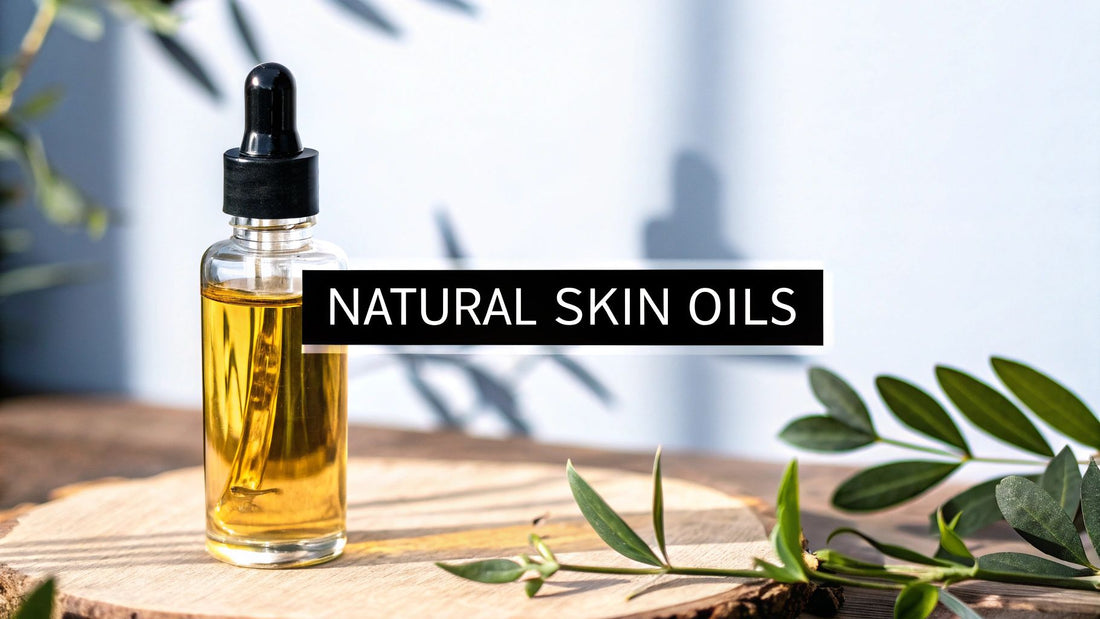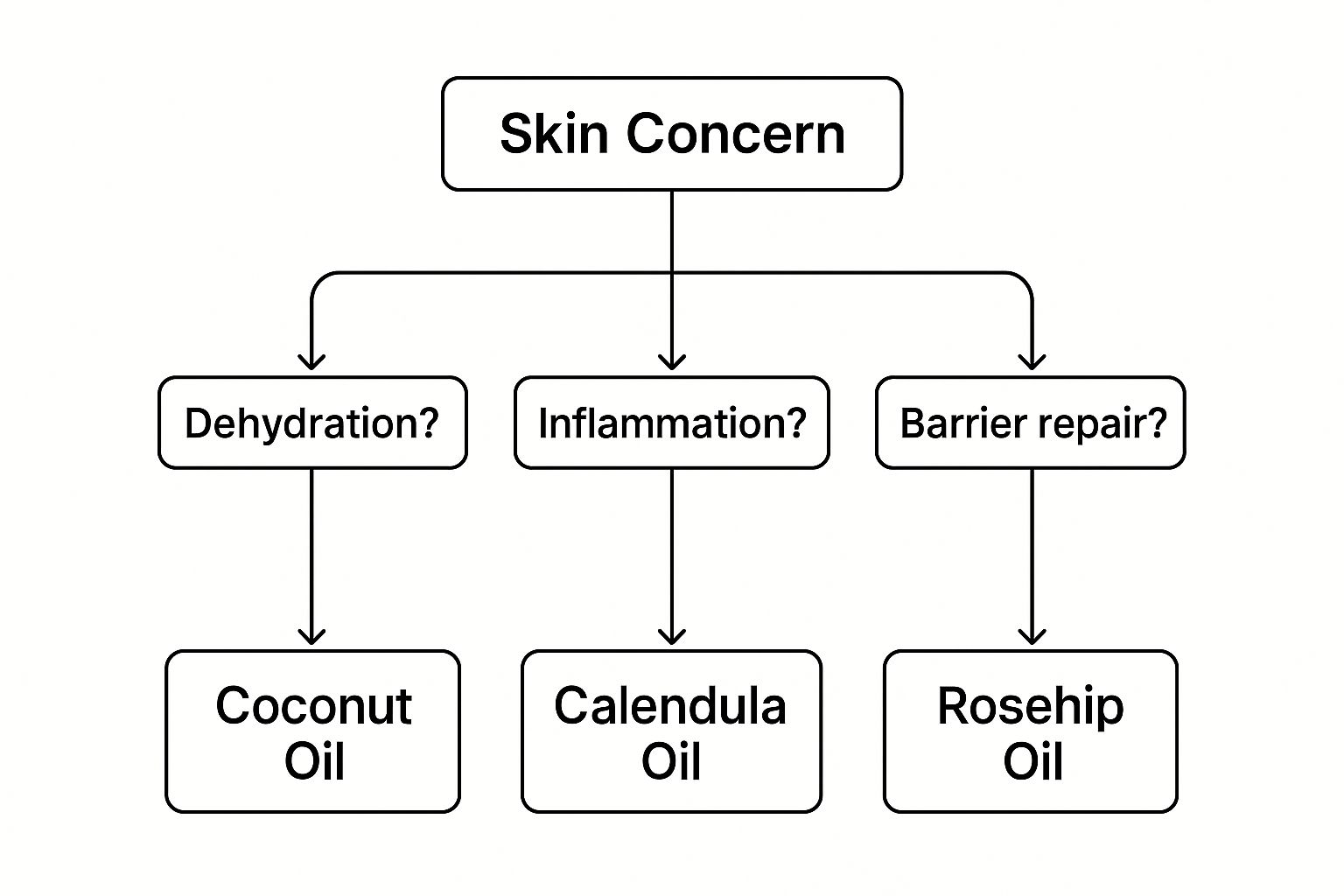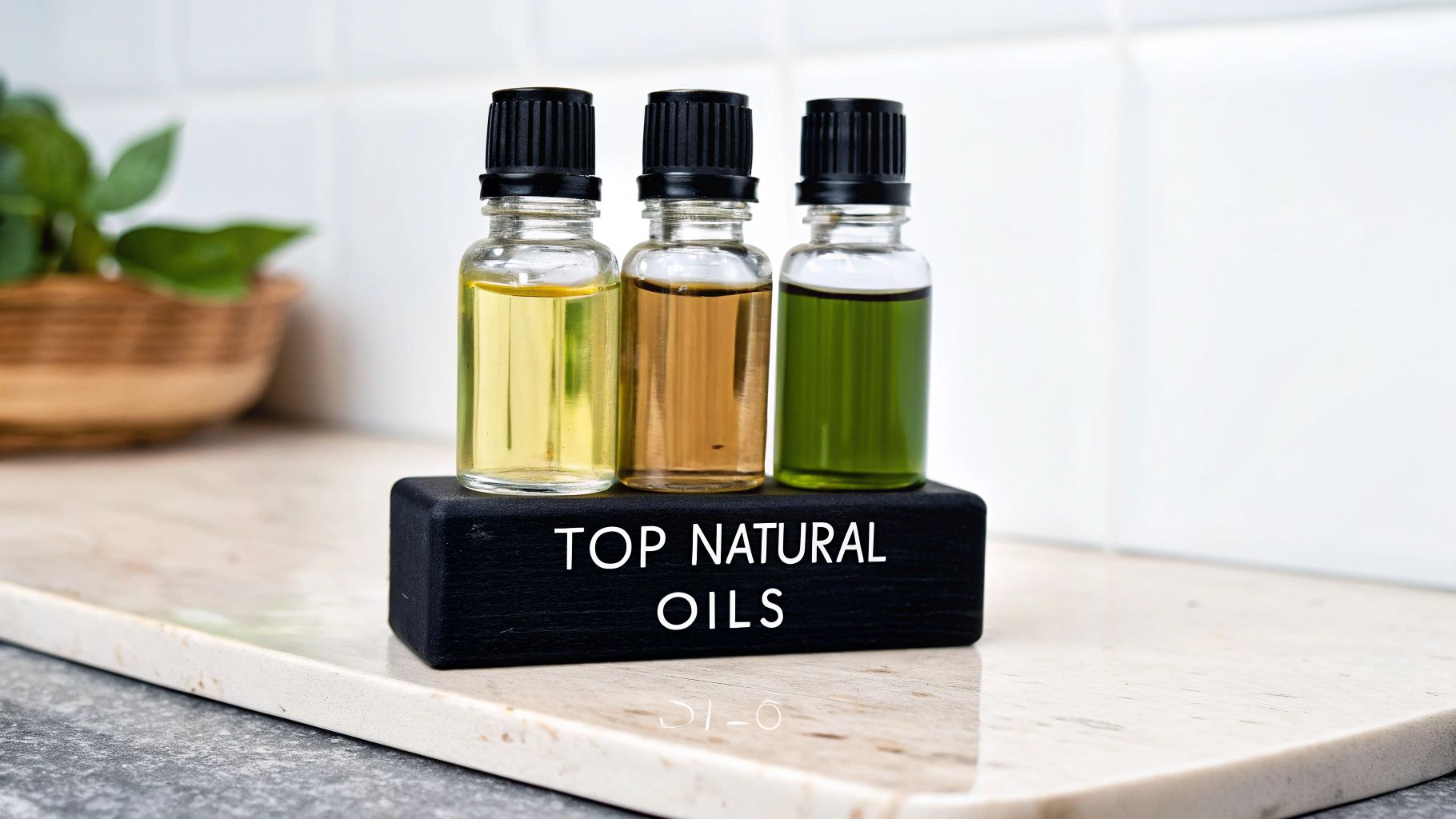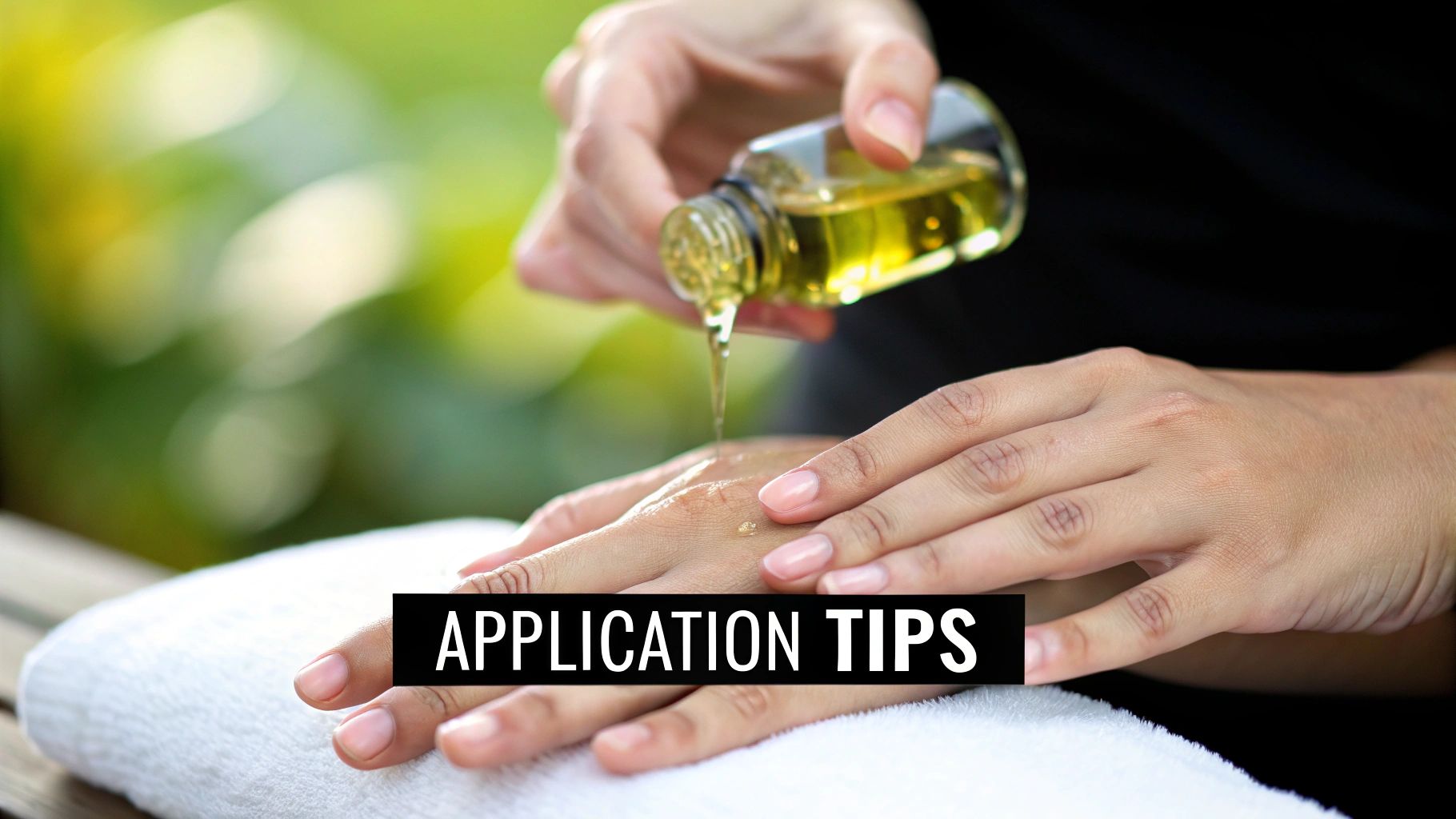
The Definitive Guide to the Best Natural Oils for Dry Skin
Share
Are you tired of lotions that promise a miracle but leave your skin parched and tight just an hour later? It’s a frustrating cycle. But the truth is, the best natural oils for dry skin operate on a completely different level. Instead of merely coating the surface, powerhouse oils like jojoba, argan, and castor oil deliver profound, lasting hydration by fundamentally restoring your skin's own protective barrier.
They are packed with essential fatty acids—the very building blocks of healthy skin—that are bio-compatible with your skin's own lipids. This isn't a temporary fix; it's about giving your skin exactly what it needs to seal in moisture for good.
Why Your Skin Is Crying Out for Natural Oils
If you're locked in a constant battle with dry, flaky, or uncomfortably tight skin, the real enemy isn't just a lack of moisture—it's a compromised skin barrier.
Think of your skin as a meticulously built brick wall. Your skin cells are the bricks, and the "mortar" binding them is a delicate matrix of natural oils and fats called the lipid barrier. When this mortar is strong and intact, your skin is supple, smooth, and deeply hydrated because it effectively locks water in.
But aggressors like harsh weather, over-cleansing, and even the natural aging process begin to erode that mortar, creating microscopic cracks. Precious moisture escapes through these gaps, leaving your skin dehydrated and vulnerable. This is precisely where natural oils intervene as the ultimate repair crew.
Rebuilding Your Skin's Natural Shield
Herein lies the critical distinction: most water-based lotions offer a fleeting burst of hydration that evaporates almost as quickly as it's applied. Natural oils, in stark contrast, get to work replenishing the very substances your skin is missing. They are brimming with essential fatty acids, the foundational components of a resilient lipid barrier.
When you apply a natural oil, you are quite literally patching the crumbling mortar in your skin's wall. This doesn't just provide immediate relief; it empowers your skin to rebuild its own defenses, leading to healthier, more resilient skin for the long haul.
This fundamental, back-to-basics efficacy is why a revolution is underway, with millions turning away from synthetic formulas to embrace the undeniable power of plants. Natural oils are the cornerstone of the global body oil market, which was valued at a staggering USD 3.1 billion and is projected to surge to USD 4.9 billion by 2034. The message is clear: people are demanding real, nourishing ingredients that solve the cause of dryness, not just mask the symptoms.
The Power of Plant-Based Lipids
So, what is the secret behind their profound effectiveness? It's all in their molecular makeup.
Many plant-derived oils, like jojoba and sunflower oil, possess a structure that is remarkably similar to the sebum your own skin produces. Because your skin recognizes them as "friend" not "foe," they are absorbed beautifully without clogging pores, delivering their potent nutrients directly where they are needed most. This payload includes:
- Linoleic Acid: An omega-6 fatty acid that is a master at reinforcing your skin’s protective layer.
- Oleic Acid: A richer, more emollient fatty acid that provides intense moisture, perfect for severely dehydrated skin.
- Antioxidants: These are your skin's personal bodyguards, neutralizing environmental stressors that lead to premature aging.
Each oil has a unique profile and a distinct set of benefits. Some, like castor oil, are unparalleled for deep conditioning and barrier restoration. If you want to understand what castor oil is good for, our detailed guide unpacks all its incredible properties. Mastering these basics is the first step toward choosing the perfect oil for your skin's transformation.
Finding the Right Natural Oil for Your Skin
Stepping into the world of natural oils can feel like entering an old-world apothecary—a beautiful, but overwhelming, array of amber bottles, each promising a unique skin miracle. With so many choices, where do you possibly begin?
The secret isn't in finding one "magic" oil. It's about finding the oil that speaks your skin's unique language. You wouldn't use an abrasive cleaner on a delicate silk fabric, and the same irrefutable logic applies to your skin. The best oils for dry skin possess specific properties that make them experts at deep hydration and barrier repair. It is simply a matter of matching the oil's strengths to your skin's needs.
This back-to-basics philosophy is precisely why people are falling in love with plant-based skincare. The natural and organic personal care market, valued at USD 28.4 billion, is projected to nearly double to an incredible USD 54.3 billion by 2032. This trend underscores a crucial distinction: 'natural' means it originates from nature, while 'organic' products elevate this by excluding synthetic pesticides and chemicals. For a growing number of us, this is the ultimate standard of trust and quality.
Decoding the Language of Oils
To choose with absolute confidence, you only need to grasp two key concepts: the comedogenic rating and the fatty acid profile. They may sound technical, but they are incredibly straightforward.
The comedogenic rating is a simple scale from 0 to 5 that indicates an oil's likelihood of clogging your pores. A 0 means it won’t clog pores at all, while a 5 signifies a high probability. This is a primary concern for oily skin, but it remains valuable knowledge for everyone.
The fatty acid profile is where the real magic happens for dry skin. Oils are composed of various fatty acids, but the two most important for you are oleic acid and linoleic acid.
- Oleic Acid: Think of this as the rich, deeply comforting fatty acid. It’s a heavier molecule that provides profound, lasting moisture. It is a godsend for very dry, mature, or compromised skin that requires serious nourishment.
- Linoleic Acid: This one is lighter and absorbs quickly. Its primary mission is to fortify the skin's natural barrier, helping it to lock in moisture and defend against external aggressors.
For most dry skin types, an oil with a healthy balance of both—or one that leans slightly richer in oleic acid—is the perfect starting point. If you're looking for more ways to quench thirsty skin, you can explore our full guide on natural remedies for dry skin.
Meet the Top Contenders for Dry Skin
Ready to meet the champions of the natural oil world? Each of these is a powerhouse for dry skin, yet they all work in beautifully distinct ways.
Jojoba Oil
This is often called nature's perfect moisturizer, and for good reason. Jojoba oil’s molecular structure is so close to our skin’s natural sebum that our skin accepts it instantly. It hydrates deeply without ever feeling heavy or greasy.
Argan Oil
Pressed from the kernels of the Moroccan argan tree, this "liquid gold" is bursting with Vitamin E and essential fatty acids. It delivers a perfect equilibrium of hydration and nourishment, making it a stellar all-rounder for nearly any dry skin concern.
Rosehip Oil
Renowned for its regenerative superpowers, rosehip oil is rich in vitamins A and C. It doesn’t just moisturize; it actively improves skin tone and texture. It's the ideal choice if you're tackling both dryness and dullness.
Coconut Oil
This is a true heavy-duty moisturizer. It’s saturated with fats that create an occlusive layer on the skin to seal in hydration. It's especially brilliant for the body—think rough patches on elbows, knees, and heels.
Choosing the right oil isn’t about finding a single "best" one. It’s about understanding which oil's unique benefits align with your skin's immediate demands, whether that's soothing inflammation, repairing the barrier, or tackling severe dehydration.
This simple chart will help you pinpoint your choice based on what your skin is asking for right now.

As you can see, your primary goal—whether it's combating dehydration, calming inflammation, or repairing damage—can direct you straight to an oil that is proven to deliver results.
A Guide to the Best Natural Oils for Dry Skin
To make your decision even easier, here is a direct comparison of these top-tier natural oils. This table breaks down their core benefits for dry skin and their comedogenic rating to help you choose your perfect match with confidence.
| Natural Oil | Best For | Key Benefit | Comedogenic Rating (0-5) |
|---|---|---|---|
| Jojoba Oil | All dry skin types, including sensitive | Mimics natural sebum for balanced hydration | 2 |
| Argan Oil | Dry, mature, or dull skin | Rich in Vitamin E for nourishment and glow | 0 |
| Rosehip Oil | Uneven skin tone and texture | High in Vitamin A for regeneration | 1 |
| Coconut Oil | Severely dry or cracked skin (body) | Forms a protective barrier to seal moisture | 4 |
Think of this table as your definitive cheat sheet. Once you identify what your skin craves, finding the right oil becomes a simple and intuitive act of self-care.
A Closer Look at a Deep Hydration Hero
Sometimes, your daily moisturizer simply isn't enough. When your skin goes beyond dry—when it's cracked, flaky, and genuinely uncomfortable—it is sending an SOS for a heavy-duty solution. This is when you must deploy something that works far beneath the surface to rebuild and restore.

Enter castor oil, specifically a pure, high-potency option like Organica Castor Oil by Niya. This is not your average, lightweight oil. Think of it as an intensive care unit for your skin, making it one of the absolute best natural oils for dry skin when you demand serious, transformative repair.
Ricinoleic Acid: The Secret Weapon
What makes castor oil so uniquely powerful? It all comes down to its extraordinary chemistry. Castor oil is overwhelmingly composed of ricinoleic acid, a rare fatty acid that makes up around 90% of its profile. This isn't just a number; it's the very source of this oil's profound healing abilities.
Ricinoleic acid is a phenomenal humectant. A humectant acts as a moisture magnet—it literally pulls water from the environment and draws it deep into the layers of your skin. While many oils excel at creating a barrier to prevent moisture loss, castor oil does that and actively pulls more moisture in.
Castor oil is a two-in-one powerhouse for parched skin. First, it soaks up moisture like a sponge. Then, its thick, rich texture locks it all in, creating a protective shield that keeps your skin hydrated for hours.
This dual-action effect is precisely why it is so masterful at conquering those stubborn dry patches that lighter oils can't touch.
Why Purity and Potency Matter
Not all castor oils are created equal. The extraction and refinement process can make or break its efficacy. Organica Castor Oil by Niya stands apart because their entire focus is on preserving the oil's innate potency and purity.
- Cold-Pressed: The oil is extracted without heat. This is non-negotiable, as heat degrades the delicate nutrients and fatty acids your skin needs to heal.
- Hexane-Free: It's guaranteed to be free of hexane, a harsh chemical solvent used in lower-quality extraction methods. There are zero nasty residues.
- Pure and Unrefined: You get 100% pure castor oil. No fillers, no additives, and no synthetic fragrances that can irritate sensitive skin.
This unwavering commitment to quality means every single drop is saturated with skin-loving ricinoleic acid, delivering the powerful, safe results you deserve.
It’s Not Just for Your Face
The true beauty of a product this pure? It's incredibly versatile. Its intense conditioning power works wonders all over your body, not just on your face.
Consider it your go-to solution for:
- Cracked Heels: Slather it on at night, and you will be astonished at how it softens even the deepest fissures.
- Dry Elbows and Knees: It creates a lasting barrier that soothes and smooths that rough, ashy skin.
- Brittle Cuticles: A small amount massaged into your nail beds restores moisture and strength.
From head to toe, Organica Castor Oil proves itself to be an indispensable, all-in-one tool for anyone serious about defeating dry skin.
How to Apply Natural Oils for Best Results
You’ve selected the perfect natural oil for your dry skin. That's a crucial first step, but the real transformation happens not just in what you use—but in how you use it. The right application technique is the difference between a greasy film and a profound, healthy glow that truly lasts.

Here's the most effective way to think about it: your skin is like a sponge. A bone-dry sponge can’t absorb much of a spill. But a slightly damp sponge soaks it right up. Your skin works the same way. Applying oil to dry skin often results in it just sitting on top. But when you apply it to damp skin, you effectively trap that moisture, ensuring hours of comfortable hydration.
The Core Application Method
This simple, three-step ritual is my definitive method for ensuring your skin absorbs every last drop of goodness. It is the foundation for getting maximum results from any facial oil.
- Start with Damp Skin: After cleansing, don't dry your face completely. Gently pat it with a towel until it's just damp. A spritz of facial mist or even plain water also works perfectly.
- Use a Small Amount: A little goes a very long way. Start with 2-4 drops in the palm of your hand. This is more than enough for your entire face and neck.
- Pat, Don’t Rub: Rub your palms together to gently warm the oil. Now, instead of rubbing, press and pat it onto your skin. This simple motion promotes far more effective absorption and avoids the friction and irritation that rubbing can cause.
Trust me, this “press and pat” method is a total game-changer. It ensures the oil penetrates deeply, giving you an even finish that feels velvety soft, not slick and oily.
Advanced Technique: Oil Cleansing
Beyond moisturizing, oils are superior cleansers. The entire principle of the oil cleansing method is rooted in basic chemistry: like dissolves like. The natural oil you massage into your skin binds to the excess oil, makeup, and impurities on your face, lifting them away without stripping your skin's vital moisture barrier.
Oil cleansing is a gentle revolution for dry skin. It provides a thorough cleanse without the harsh sulfates found in many traditional cleansers, leaving your skin feeling clean, soft, and comfortable—never tight or stripped.
Here’s a simple guide to trying it yourself:
- Step 1: With dry hands, massage about a teaspoon of oil (jojoba and castor are excellent choices) onto your dry face for at least a minute. Take your time.
- Step 2: Take a clean washcloth and soak it in warm water. Wring it out and lay it over your face for 30 seconds. The steam will help open your pores.
- Step 3: Gently wipe the oil away with the cloth. You'll be left with skin that feels impeccably clean, hydrated, and perfectly prepped for your next step.
Whether you're pressing in a few drops for moisture or performing a full oil cleanse, mastering these techniques will unlock the true, transformative power of your natural oils.
How to Choose a High-Quality Natural Oil

Simply choosing an oil from a "best of" list is not enough. The true magic—and the dramatic results you're seeking—is entirely dependent on its quality. Think of it like grocery shopping. You have a choice between a hyper-processed snack and fresh, whole foods. For your skin, you must always choose the equivalent of fresh, organic produce to reap the most potent benefits.
This means you need to read labels like an expert. The terms might seem technical at first, but they reveal everything you need to know about what's inside the bottle. A truly high-quality oil can work wonders, while a low-quality, over-processed version will be ineffective at best and irritating at worst.
Decoding the Label
To guarantee you're getting a top-tier product, there are a few non-negotiable terms you must always look for on the packaging. These are the hallmarks of a pure, potent, and effective oil.
-
Cold-Pressed: This is paramount. It means the oil was extracted without high heat, which is critical because heat annihilates the delicate vitamins, antioxidants, and fatty acids your skin craves.
-
Unrefined (or Virgin): This tells you the oil exists in its most natural, powerful state. Refined oils are often bleached or deodorized with chemicals, a process that strips them of their most valuable nutrients.
-
Organic: A certified organic seal is your assurance that the oil is free from synthetic pesticides and other harmful chemicals. It is the purest choice, ensuring only clean, natural ingredients touch your skin.
This demand for clean, unadulterated ingredients is reshaping the entire industry. The global cosmetic oils market, valued at USD 13.73 billion, is projected to skyrocket to USD 47.29 billion by 2035. This explosive growth is driven by consumers just like you who are demanding better, purer options.
Just like with food, the less processed your skincare oil is, the more nourishing it will be. Choosing cold-pressed and unrefined ensures you get 100% of the plant's natural goodness.
Packaging and Purity Red Flags
Finally, inspect the bottle itself. This is another vital clue. High-quality oils are photosensitive; light and air cause them to oxidize and lose their potency.
-
Look for Dark Glass: Always choose oils packaged in amber, cobalt blue, or other dark-colored glass bottles. This shields the delicate oil from UV light, keeping it fresh and effective for far longer.
-
Check the Ingredients List: The list should be refreshingly short. If you see "fragrance," "parfum," or a long list of chemical names you can't pronounce, put it back on the shelf.
Once you know these simple quality markers, you can shop with total confidence. If you're ready to explore different types of oils, our guide on the best carrier oils for skin is the perfect next step on your journey.
Common Questions About Using Natural Oils
Diving into facial oils for the first time can be intimidating. If questions and doubts are swirling in your mind, you are not alone. Let’s dismantle the most common fears and get you ready to fully embrace the power of natural oils for your dry skin.
Will Natural Oils Clog My Pores?
This is the number one concern, isn't it? The idea of putting oil on your face, especially if you’ve ever experienced a breakout, feels counterintuitive. But this fear is based on a misunderstanding. It all comes down to choosing the right oil.
Many incredible oils, like argan and rosehip, are non-comedogenic. This is simply the scientific term for "very unlikely to clog pores." Their molecular structure is light and readily absorbed. Even richer, more nourishing oils are perfectly fine when applied correctly—a few drops is all you need.
Can Oils Make My Skin Feel Greasy?
If your skin feels like an oil slick after application, it is almost always due to one of two user errors: you’ve applied far too much, or you've applied it to bone-dry skin. A high-quality oil should leave your skin feeling soft and nourished, never greasy.
This is why the "damp skin" technique is so crucial. Applying just 2-4 drops of oil to your face while it's still slightly damp helps it spread evenly and absorb almost instantly, trapping that water in your skin. The result is a healthy, radiant glow, not a layer of grease. If it ever feels heavy, you've used too much.
The purpose of a facial oil is not to sit on your skin like a shiny barrier. It is to deliver essential fatty acids deep into the epidermis, helping your skin repair its own moisture barrier from the inside out.
How Long Until I See Results?
You will feel an immediate difference. That tight, thirsty sensation will vanish after the very first use. But for the profound, lasting changes, consistency is key.
Your skin undergoes a renewal cycle that takes approximately 28 days. With daily application, you will see a significant improvement in your skin's texture, softness, and overall health within just a few weeks. The true magic unfolds over time, as your skin becomes stronger and learns to retain moisture all on its own.
Can I Mix Different Oils Together?
Absolutely! This is one of the greatest advantages of using natural oils. Think of yourself as a skincare alchemist, creating a bespoke blend tailored precisely to your needs.
You can combine a "carrier" oil, like jojoba, with a more targeted "specialty" oil, like rosehip or argan, to get the best of both worlds. An excellent starting ratio is about two-thirds carrier oil to one-third specialty oil. This allows you to customize your routine perfectly, whether you need more hydration, a vitamin C boost, or something to calm redness. Just remember to introduce new oils one at a time to see how your skin responds.
Ready to find the perfect oil to begin your journey to hydrated, happy skin? Explore the pure, potent, and deeply nourishing options from terravera.
